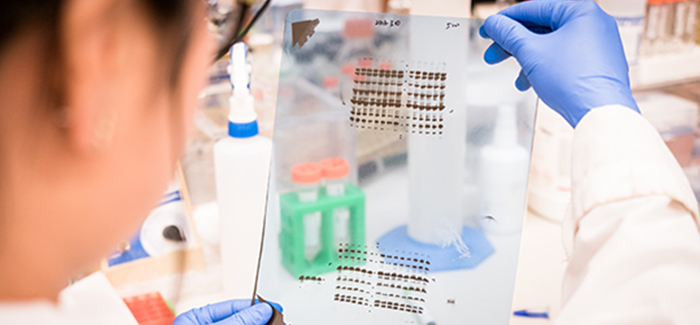Troubleshooting using anti-light chain antibodies

Anti-light chain antibodies are commonly used for Western blotting (WB) after Immunoprecipitation (IP) when detecting proteins that migrate to approximately 50kDa with IP and WB primary antibodies from the same host species. These proteins would otherwise be obscured by detection of the heavy chain from the precipitating antibody. Unlike whole molecule-specific antibodies, which detect both heavy and light chains, the anti-IgG, Light Chain Specific antibodies only detect light chains. Consequently, the native primary antibodies used for WB are detected by recognition of their light chains, while the heavy chain of the IP antibody is not detected. Consequently, proteins of interest of approximately 50 kDa can be resolved on a blot without an overlapping signal from the IP antibody heavy chain.

Troubleshooting your IP
Setting up an IP should be straightforward, but sometimes unexpected results can occur. Here are some quick tips to help you troubleshoot your IP with Anti-Light Chain-specific antibodies.| Problem | Solution | |
|---|---|---|
| No Signal Detected | Was the product reconstituted in dH2O only as described on the specification sheet? | Always reconstitute the antibody as described on the spec sheet. |
| Typically this is using dH20. Never rehydrate in glycerol. | ||
| If glycerol was added, is it ACS grade (98%?) or better? | If glycerol has been added to extend storage, we recommend reconstituting in water and then adding ACS grade glycerol to 50%. | |
| Was it stored properly? | If glycerol was added, the entire vial can be placed at -20°C. Alternatively, store with no glycerol in small aliquots at -70°C or colder. | |
| Band detected at approximately heavy chain size (50kDa) | How much antibody was used for the IP? | Using an excess of IP antibody is not necessary for pulling down a protein of interest that is in low abundance. You can optimize the amount of IP antibody needed by titrating the antibody and monitoring the protein of interest remaining in the supernatant by WB. |
| Has the gel been overloaded? | IP is a sensitive assay, so optimization may be necessary to ensure gel isn’t overloaded with protein. We recommend using 50 - 100ng of protein/ well. | |
| How does the band of interest compare to the corresponding light chain band? | Blot can be overexposed if the light chain has been run off. Overexposure may result in non-specific protein or background signals. | |
| Was the reducing agent made fresh and added to the sample? | Always add reducing agents such as BME (beta-mercaptoethanol ) or DTT (Dithiothreitol) to your loading buffer on day of use. | |
| Have appropriate control experiments been performed? | Use the control section below to help solve the identity of your band at 50kDa. | |
| Have manufacturer instructions been followed? Has the protein AG Dissociated from the bead? | Always check manufacturers' instructions. | |
| Boiling the beads may not be recommended for some antibody species. | ||
| Protein A/G and protein G beads have also been shown to occasionally come off the beads during the boiling process, retaining partial activity. | ||
| Active Protein A/G on the blot can bind the primary or secondary detection antibodies, giving the appearance of cross-reactivity at the heavy chain or other non-specific bands. | ||
| Using beads alone as a control can help determine if this is happening. | ||
| Has the membrane been blocked? | We suggest blocking with BSA or normal serum of the secondary antibody host. Some manufacturers’ blocking agents can contain proteins that may cause background. Avoid blocking with skimmed milk powder. | |
| Are you using the appropriate dilution of the secondary antibody? | For ECL, the recommended dilution range is 1:10,000 to 1:200,000. |

Essential controls for Western blotting after IP
When setting up a Western blot after an IP, appropriate controls can be used to help interpret results and identify the protein of interest.| Method | Outcome | |
|---|---|---|
| Positive Control (IP antibody) | The positive control should include a 0.5-2 ug sample of the IP antibody and probed with only the secondary antibody under reducing conditions. | Characterization of the size(s) the denatured IP antibody migrates and their detection by the secondary antibody. |
| Positive control (primary antibody) | Run the probing antibody directly on the SDS-PAGE and detect with the secondary antibody. | Confirmation that secondary antibody recognizes the primary. |
| Positive control (sample) | Ideally a small amount of purified target protein should be loaded. | Confirmation that the primary antibody is suitable for the detection of the target protein. |
| Negative Control (Bead only) | The negative control should include beads only. An equivalent quantity of beads should be loaded into a well of the SDS-PAGE gel as would be loaded from the IP sample. | If capture antibody/ protein A/G have dissociated from the beads, then there may be a signal in this lane. |
| Sample only/ pre IP / input | Load one well with the un-enriched sample and probe with primary and secondary. | Confirmation that no contaminants are creating unexpected bands. |
| Flow through | Run the supernatant that’s been exhausted of target protein. | If your IP antibody is effective at depleting target protein from supernatant, then this lane will be blank |
| Protein A/G only control | Run a sample containing the capture agent if protein A or G was used and probe with primary and secondary. | Compare migration of band to that of other components to rule out contamination from protein A or G. |

| Learn more: | Do more: |
|---|---|
| Colorimetric western blotting | Western blotting guide: Part 1 |
| Chemiluminescence western blotting | Antibodies for signal enhancement |
| Fluorescent western blotting | |

